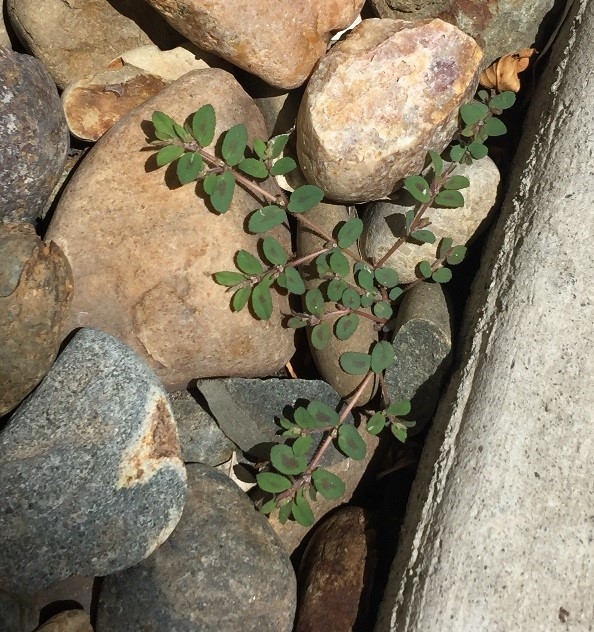Spotted Spurge Scourge
Spotted Spurge (Euphorbia (=Chamaesyce) maculata) is a garden weed that can seem impossible to control. It grows rapidly and starts producing seeds at a very small size. A large plant can produce thousands of seeds. If you pull the weed and leave it lying in the garden, many of the seeds left on the plant will be jumping off to your garden soil before you gather it up for disposal. Spurge seeds will likely emerge from the compost bin still viable, and most gardening sites recommend you exclude all weed seeds from composting. Other weeds that may survive the composting process are oxalis bulbs and the seeds of burclover, amaranth, and cheeseweed.)
Spotted Spurge usually, but not always, has a red or maroon colored spot in the middle of its small oval leaves. The reddish stems contain a milky juice that can cause irritation to skin and eyes upon contact. It grows like a mat, close to the ground which can reach 3 feet across. Aside from growing on any spot of bare soil no matter how poor, in is just as happy to take up residence in a crack in your sidewalk, Seeds form in a tiny triangular pod containing 3 seeds. You may not be able to see these without magnification. The plant can be found in our area from February through September, and seeds begin germination with temperatures reach 60 degrees.
Other names for this plant include Spotted Euphorbia, Spotted Sandmat, and Prostrate Spurge. There are other related forms of Spurge that are not as much of a garden pest. However, some of these spread by roots and may be considered invasive. These include Petty Spurge, Nodding Spurge, and Leafy Spurge (Euphorbia esula). The latter comes in many colorful varieties and is often found in seed or plant catalogs.
The best way to outmaneuver spotted spurge is to pull it by hand when it is small or use a thick mulch, to prevent or discourage its germination. There are commercial sprays that will kill the plant, but the plant will still need to be hand-pulled, wearing gloves, to keep those remaining seeds from being left in the plant's footprint. For the driveway or sidewalks, this is one application where a flame weeder /garden torch could be considered.
Folklore about spurge concerns the milky juice in the stems, which has been claimed to remove warts. Here is one such story. “When I was a very young boy (about 5 years old) I went to a gypsy camp close to Bodmin (Cornwall, England). There was a lady there complaining that the gypsy lady had failed to ‘charm' a very disfiguring wart on her face. The gypsy said she had another way provided she was given silver. Wartweed was produced and the ‘milk' applied to the wart, and she was told to do this daily. The husband refused to pay. The gypsy then cursed him and rubbed his forehead with wartweed. Later that day we saw the husband in Bodmin and there was a bright red cross on his forehead.”
For further information, go to the UC-IPM web site at:
http://ipm.ucanr.edu/PMG/WEEDS/spotted_spurge.html

Small spurge plant. (photo by David Bellamy)


Posted by Launa Herrmann on January 25, 2020 at 11:42 AM